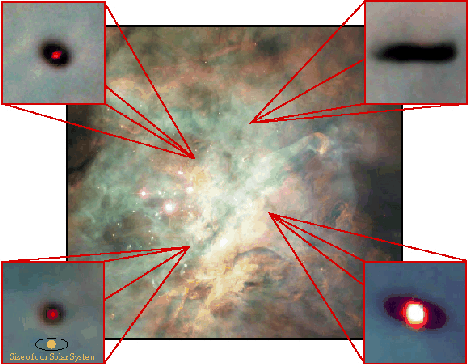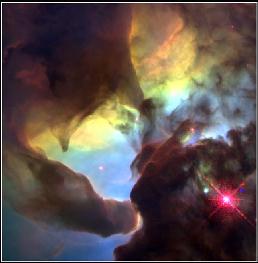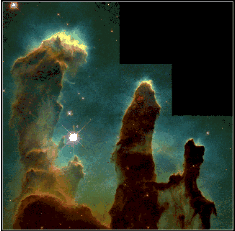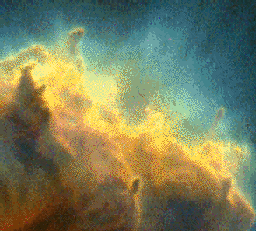 |
| Regions in the Orion Nebula where solar systems appear to be forming |
The nebular hypothesis for the origin of our Solar System has been bolstered by a variety of recent observations that look very much like star and planetary systems in various stages of formation.
 |
| Regions in the Orion Nebula where solar systems appear to be forming |
The Orion Nebula is approximately 1500 light years from Earth. It is
visible to the naked eye as the
middle "star" in the sword of the
constellation Orion.
These images were taken with the
Wide Field Planetary Camera 2 of
the Hubble Space
Telescope (C.R. O'Dell,
Rice University).
Details of the
images show several protoplanetary disks (
proplyds ),
including a single
dark disk surrounding a central
star
(Ref). The lower left inset figure shows a drawing giving the approximate
scale of our Solar System relative to the proplyd.

Here is a movie illustrating these protoplanetary disks in the Orion Nebula source), here is a further discussion of these planetary systems now forming in Orion.
 |
 |
| Star-Birth Clouds in M16 (Eagle Nebula). J. Hester and P. Scowon (Arizona St. Univ.), November 2, 1995. Taken with NASA Hubble Space Telescope, WFPC2 | |
The scale of the image on the left is about 1 light year. The blowup on the right shows finger-like structures that are thought to be regions in which new stars are being formed. The tips of these finger-like objects are about the size of our Solar System! Here is a movie of these star-forming regions in the Eagle Nebula made with the Hubble Space Telescope (Source). This movie is about as close as you are ever going to get to the bridge of the Starship Enterprise!